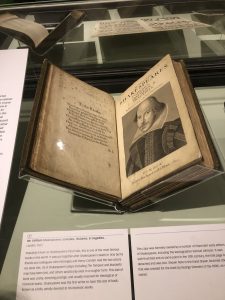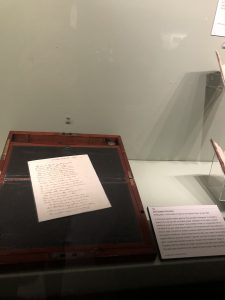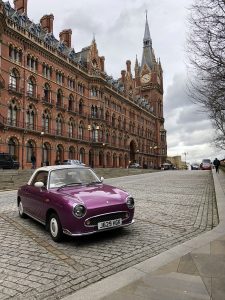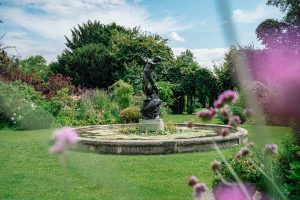Manuscripts and Much More: Hands-on Learning in the Humanities
Let’s take a short little trip back in time, just a few weeks really. It’s 7:30 am on a Saturday morning in Leeds and I have a train to catch to London in half an hour.

I’m frantically trying to wipe last night’s make up off, simultaneously contemplating if a piece of gum is an appropriate substitute for brushing my teeth (in times of crisis, that’s really neither here nor there), and trying to absorb the fact that I’ve just received an email from UVic telling me that I have to return back to Canada from my exchange as soon as possible in light of escalating developments with COVID-19.
But this isn’t a post about living in Europe during a pandemic, or the emotional roller coaster that came the following week as I had to say goodbye to the city and people I had so grown to love. No, this post is a love story of a different kind. A brief, gushing summary of what it was like to explore a small part of London for just one day as an extremely enthusiastic English major.
My flatmate and I arrived in King’s Cross Station after a two and a half hour train journey slightly disoriented, but above all elated. We came to London specifically to visit the British Library, but had hours to kill before the tour was supposed to begin.
So we began the day just by wandering the streets around Marylebone, a relatively quiet part of London filled with boutiques and picturesque side streets. As we walked further into Marylebone, magnolia trees bloomed behind the walls of courtyards and small colonies of daffodils created sunny breaks in the grey, concrete heavy streets. Suddenly before us, a vast green field surrounded by massive gnarled trees appeared beyond the pristine white washed buildings. My heart skipped a beat when I saw the sign reading “Regent’s Park”.
Last year, I had the pleasure of taking a class on Victorian novels and I wrote my final paper on female agency in nature as presented in the book The Story of a Modern Woman by Ella Hepworth Dixon.
My paper focused on the main character’s intimate relationship with Regent’s Park as she fled there to escape the horrors of Industrial Revolution era London and a soured love affair. And suddenly there I was. In the very park I had written about and done research on.

It was not as I had imagined it, which wasn’t at all disappointing. I had pictured it to be lush and filled with shrubs and small forests, and it may have been 150 years ago. But on this March day in 2020, Regent’s Park was filled with soccer fields and walk ways lined with beautiful old trees.
Couples strolled holding hands and dogs raced after balls. And as we walked, I understood why the protagonist of the book came to the park to escape the world. It was infinitely more quiet than the rest of the city, even the air felt cleaner. Everyone walked with such leisure, that you couldn’t help but also feel at ease.
After lunch and more exploring, we arrived at the British Library. Much like Regent’s Park, my imagination proved to be quite different from reality. I had anticipated a grand, gothic building, lined with floor to ceiling mahogany book cases filled with ancient leather bound texts. But actually, the British Library looks a lot like my junior high school: burgundy and hopelessly stuck in the 1980s. However, what it held inside made my heart skip about ten more beats.
Our tour began in front of a three story glass enclosed book case where our guide casually pointed out Henry VIII’s Bible and the original translated works of Martin Luther. The historical weight that these text’s carried did not at all match their tiny size (although Henry VIII’s Bible was quite massive by average book standards, to match his ego and personality I assume).
What was perhaps the most exciting was the Library’s “Treasures” collection where the Library put on display some of their most impressive and significant manuscripts and artifacts.

As I’m writing this, I’m really trying to think of the best way to summarize what it was like to walk into a room that held Mozart’s hand written sheet music, Jane Austen’s tiny writing desk, Shakespeare’s first folio, and the Magna Carta, among other things, without just creating a grocery list of artifacts or a novel length description of what it was like looking at each object.
I think the best way to capture the experience is through gasps. Literal gasps. My flatmate and I dispersed around the huge room, taking our time to look at the objects that interested us most. And while I was lost in thought staring at Sylvia Plath’s bubbly printing, I would hear my friend slightly gasp with excitement and would scurry over to see what she had been so in awe of. And she would do the same when she heard me squeal at the sight of something.
But perhaps the artifact that gave me the most pause were the wood blocks engraved by John Tenniel to be used for the illustrations in Alice in Wonderland. In the Victorian Children’s Literature class I took last year, we had looked at these wood blocks as images on the internet and as PDFs. We analyzed the illustrations closely, learning extensively about the careful work and process that went into producing the illustrations. I remember hearing my professor talk about how she felt looking at these same wood blocks when she was in London. I bent down and look at each block as closely as I could from behind the glass case. The lines were so fine and intricate and the blocks could fit in the palm of your hand.
To see something you’ve only heard about and seen projected onto a screen is humbling. It feels like the occasionally abstract world of academia was coming together with a tangible reality to create a surreal, almost dream like experience. As an English student, you don’t get to experience a lot of “hands on learning” unless you’re looking at manuscripts or you visit the places authors and poets write about. And it’s the same case for a lot of other humanities courses. History classes take on a different meaning when you have the opportunity to interact with artifacts and historical sites, and I can only imagine the excitement a Greek and Roman Studies student would feel at the sight of the Acropolis.
 That is not to say that in order to experience hands on learning as a humanities student you need to travel across the world to look at an old book or a statue.
That is not to say that in order to experience hands on learning as a humanities student you need to travel across the world to look at an old book or a statue.
What this experience taught me was that yes, old books, wood blocks, and big British parks are super cool, but also behind all the theory and analysis we learn as humanities student, there are also real and tangible artifacts and places.
Even if these things aren’t readily accessible to us, to know that they are out there and that we too can contribute to the studies and scholarship of these things is exciting! It also puts into perspective that the work we are producing in the present moment could one day end up behind glass cases and be studied in the same way.
The humanities is all about embracing and thinking about what makes us human. These magnificent and fascinating artifacts, historical movements, and manuscripts are the result of people from the past who are just as human as you or I. And there’s something truly wonderful about that.





I LOVE THIS
ELLA HEPWORTH DIXON WOULD STAN THIS
Beautifully written. I can feel it and experience it through your descriptions.